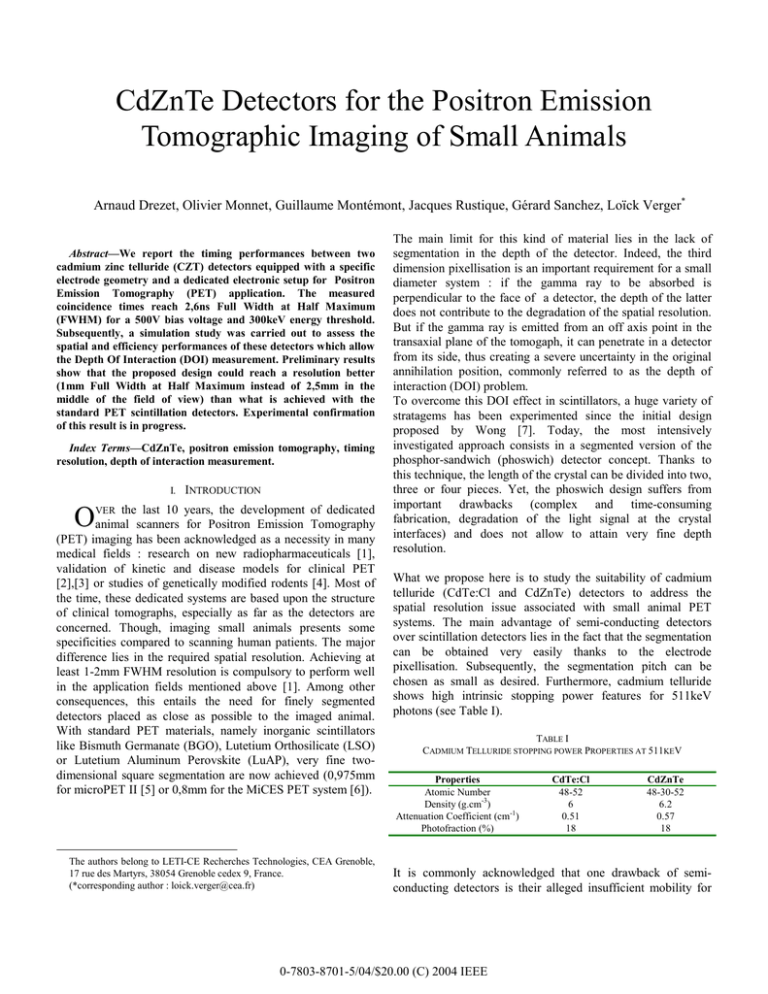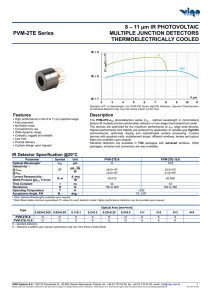R11-67 CdZnTe Detectors for the Positron Emission
advertisement

CdZnTe Detectors for the Positron Emission Tomographic Imaging of Small Animals Arnaud Drezet, Olivier Monnet, Guillaume Montémont, Jacques Rustique, Gérard Sanchez, Loïck Verger* Abstract—We report the timing performances between two cadmium zinc telluride (CZT) detectors equipped with a specific electrode geometry and a dedicated electronic setup for Positron Emission Tomography (PET) application. The measured coincidence times reach 2,6ns Full Width at Half Maximum (FWHM) for a 500V bias voltage and 300keV energy threshold. Subsequently, a simulation study was carried out to assess the spatial and efficiency performances of these detectors which allow the Depth Of Interaction (DOI) measurement. Preliminary results show that the proposed design could reach a resolution better (1mm Full Width at Half Maximum instead of 2,5mm in the middle of the field of view) than what is achieved with the standard PET scintillation detectors. Experimental confirmation of this result is in progress. µ Index Terms—CdZnTe, positron emission tomography, timing resolution, depth of interaction measurement. I. INTRODUCTION last 10 years, the development of dedicated Oanimalthescanners for Positron Emission Tomography VER (PET) imaging has been acknowledged as a necessity in many medical fields : research on new radiopharmaceuticals [1], validation of kinetic and disease models for clinical PET [2],[3] or studies of genetically modified rodents [4]. Most of the time, these dedicated systems are based upon the structure of clinical tomographs, especially as far as the detectors are concerned. Though, imaging small animals presents some specificities compared to scanning human patients. The major difference lies in the required spatial resolution. Achieving at least 1-2mm FWHM resolution is compulsory to perform well in the application fields mentioned above [1]. Among other consequences, this entails the need for finely segmented detectors placed as close as possible to the imaged animal. With standard PET materials, namely inorganic scintillators like Bismuth Germanate (BGO), Lutetium Orthosilicate (LSO) or Lutetium Aluminum Perovskite (LuAP), very fine twodimensional square segmentation are now achieved (0,975mm for microPET II [5] or 0,8mm for the MiCES PET system [6]). The authors belong to LETI-CE Recherches Technologies, CEA Grenoble, 17 rue des Martyrs, 38054 Grenoble cedex 9, France. (*corresponding author : loick.verger@cea.fr) The main limit for this kind of material lies in the lack of segmentation in the depth of the detector. Indeed, the third dimension pixellisation is an important requirement for a small diameter system : if the gamma ray to be absorbed is perpendicular to the face of a detector, the depth of the latter does not contribute to the degradation of the spatial resolution. But if the gamma ray is emitted from an off axis point in the transaxial plane of the tomogaph, it can penetrate in a detector from its side, thus creating a severe uncertainty in the original annihilation position, commonly referred to as the depth of interaction (DOI) problem. To overcome this DOI effect in scintillators, a huge variety of stratagems has been experimented since the initial design proposed by Wong [7]. Today, the most intensively investigated approach consists in a segmented version of the phosphor-sandwich (phoswich) detector concept. Thanks to this technique, the length of the crystal can be divided into two, three or four pieces. Yet, the phoswich design suffers from important drawbacks (complex and time-consuming fabrication, degradation of the light signal at the crystal interfaces) and does not allow to attain very fine depth resolution. What we propose here is to study the suitability of cadmium telluride (CdTe:Cl and CdZnTe) detectors to address the spatial resolution issue associated with small animal PET systems. The main advantage of semi-conducting detectors over scintillation detectors lies in the fact that the segmentation can be obtained very easily thanks to the electrode pixellisation. Subsequently, the segmentation pitch can be chosen as small as desired. Furthermore, cadmium telluride shows high intrinsic stopping power features for 511keV photons (see Table I). TABLE I CADMIUM TELLURIDE STOPPING POWER PROPERTIES AT 511KEV Properties Atomic Number Density (g.cm-3) Attenuation Coefficient (cm-1) Photofraction (%) CdTe:Cl 48-52 6 0.51 18 CdZnTe 48-30-52 6.2 0.57 18 It is commonly acknowledged that one drawback of semiconducting detectors is their alleged insufficient mobility for 0-7803-8701-5/04/$20.00 (C) 2004 IEEE PET [8]. In the past 17 years, several studies were undertaken to evaluate the timing performances of CdTe and CdZnTe pertaining to the PET application [9] – [19]. The results obtained, with a mean coincidence value around 10ns FWHM for cadmium telluride detectors of small volume, can be considered to be promising, though not entirely satisfying. To this connection, it is worth noticing that all these research works focused on the optimization of the physical and geometrical characteristics of the detectors, but did not study the influence of the electronic setup, specifically the crucial preamplifier stage. In this work, we present the results of the optimization of the electronic setup in terms of improvement of the coincidence timing response between cadmium telluride detectors. We also report on simulations carried out thanks to the Monte Carlo package Penelope to assess the efficiency and the spatial resolution reachable by CdTe detectors. II. DETECTOR GEOMETRY AND PREAMPLIFIER STAGE To obtain the fastest response from the CZT detectors without jeopardizing their detection efficiency, we choose and adapt the planar transverse field configuration presented in [20] for the electrode geometry. In our case, both faces have stripped electrodes as shown in Fig. 1. Fig. 2. Experimental setup to measure the timing resolution between two cadmium telluride detectors in coincidence (Spectrometric amplifier : Ortec Model 570, Time to Amplitude Converter : Ortec Model 467, Multi-Channel Analyzer : Canberra AccuSpec). The home-made x10 amplifier stages are needed to provide the Constant Fraction Discriminator (Fast Comtec Model 7029A) with signals of sufficient amplitude. Several studies were undertaken to assess the role played by different parameters (energy threshold, inter-electrode distance…) in the timing resolution finally obtained. The most striking results are presented in Fig. 3. They deal with the influence of the applied bias voltage between the detector electrodes on the coincidence timing resolution. These measurements are performed with all anode strips connected to each other, as well as all cathode strips. At 500V, we measure a timing resolution of 2,6ns FWHM. This result suits well with preliminary measures carried out between a CZT detector and a BaF2 crystal (1,9ns FWHM), and is compatible with the timing window of a PET scanner of the order of 10ns. Fig. 1. Design of the cathode and anode faces. Detectors are 20mm long, 16mm wide, and the inter-electrode distance is 0.9mm. The anode and cathode strips are 0.9mm (pitch 1mm) and 3.9mm (pitch 4mm) wide, respectively. The cathode segmentation allows the DOI measurement. The customized preamplifier is composed of a low noise (10-20C.Hz-1/2 at 20MHz when connected to a 10pF capacity detector) charge-sensitive amplifier with a fast differentiator stage delivering output signal rise times as short as 6ns. III. EXPERIMENTAL RESULTS The setup consists of two CZT detectors arranged on opposite sides of a 68Ge source emitting two back-to-back 511keV photons. We use standard nuclear instrumentation modules as shown in Fig. 2 [14]. Fig. 3. Coincidence timing resolution between two CZT detectors as a function of applied bias voltage. IV. SIMULATION RESULTS We use the Monte Carlo package Penelope [21] to simulate the 3D detection module, shown in Fig. 4, and to evaluate its efficiency and spatial resolution performances. It corresponds approximately to 2 arrays of 16 piled up detectors presented in Fig. 1. 0-7803-8701-5/04/$20.00 (C) 2004 IEEE We compare the CZT results, with and without depth of interaction (DOI) measurement, to what is obtained with three scintillator detector modules, namely those from ATLAS, microPET Focus and microPET 2 [5], conducting an almost equivalent simulation procedure (see Fig. 6, 7 and 8). The main difference is that we use a barycentric algorithm to reconstruct the interaction location in the case of scintillators instead of having a direct electronic localization in the voxels. Fig. 4. Schematic view of the simulated CZT detector. The 16x16 module is 16mm wide, 16mm high, 40mm deep, and is divided into 2560 voxels. The one-dimensional photon beam created by a punctual radiation source perpendicularly hits the detector surface on the central voxel. Compton and photo-interactions occur in the material, and we monitor the voxels in which an energy superior to a predetermined threshold is deposited. If one or two voxels are excited above this threshold, we derive the transaxial spatial resolution reachable with the detector from their localization. The simulation procedure is summarized through the Fig. 5 shown below. Fig. 6. Geometry of the simulated LGSO/GSO ATLAS detector. Each crystal is 2mm wide and 2mm high. The 9x9 module is 18mm wide, 18mm high, comprises 2 layers of LGSO 7mm and GSO 8mm deep. Fig. 7. Geometry of the simulated LSO microPET Focus detector. Each crystal is 1,6mm wide and 1,6mm high. The 12x12 module is 19,2mm wide, 19,2mm high, 10mm deep. Fig. 8. Geometry of the simulated LSO microPET 2 detector. Each crystal is 1mm wide and 1mm high. The 14x14 module is 14mm wide, 14mm high, 12,5mm deep. Fig. 5. Illustration of the simulation procedure. The studied detector is illuminated by a 1D gamma ray beam at the surface of a precise voxel. After interaction in the detector, a spatial profile is constructed on the radial transaxial plan by taking into account a reference detector in virtual coincidence with the simulated detector. As shown in Fig. 9, the DOI measurement in the CZT detector considerably increases the spatial resolution when moving off the center of the field of view. Furthermore, this design could potentially achieve a resolution more than two times better (1mm against 2,5mm FWHM) than what is obtained with the a scintillator detector. 0-7803-8701-5/04/$20.00 (C) 2004 IEEE Fig. 11. 3D representation of simulated parallelepiped (left) and trapezoidal (right) CZT detectors. Fig. 9. Comparison of CZT and scintillator transaxial spatial resolution. As for the detection efficiency (see Fig. 8), the 40mm-deep CZT detector is slightly superior to the 10mm-deep LSO detector. Fig. 12. Comparison of trapezoidal CZT and scintillator detector efficiency. V. EXPERIMENTAL VALIDATIONS Fig. 10. Comparison of CZT and scintillator detector efficiency. To confirm the simulation results, a multichannel experimental bench has been set up. It consists of two detectors, as described in Fig. 1, put one behind the other to obtain a total depth of 40mm. The 16 anodes and 10 cathodes are connected to 26 identical preamplifiers (see Fig. 12). The generated signals are fed into customized constant fraction discriminators put on 8 electronic boards (see Fig. 13), each controlled by an FPGA. The data are processed through a Labview program. To improve the efficiency of CZT detectors, especially the homogeneity of detection across the field of view, we choose to evaluate a trapezoidal geometry alternative to the common parallelepiped form (see Fig. 10). With such a configuration, the CZT detectors offer an efficiency equal or superior to all the simulated scintillator detectors. The results are shown in Fig. 11. Though, it remains to be seen whether such a geometry can be experimentally exploited. Fig. 13. Experimental bench in progress (Motherboard with 16 preamplifiers). 0-7803-8701-5/04/$20.00 (C) 2004 IEEE VII. REFERENCES [1] [2] [3] [4] [5] Fig. 14. Experimental bench in progress (Board with 4 CFD). Only preliminary settings have been carried out so far. They prove the bench to be functional (see Fig. 14). [6] [7] [8] [9] [10] [11] Fig. 15. Temporal dispersion among the electronic channels without delay compensation. The values obtained, around 1,9ns FWHM for CZT/BaF2 coincidences, are consistent with the timing results presented previously (2,6ns FWHM for CZT/CZT coincidences). VI. CONCLUSIONS [12] [13] [14] We have jointly developed a specific three-dimensional CdZnTe detector geometry and a preamplifier stage to achieve the best coincidence timing performance between 2 CZT detectors. The 2,6ns FWHM measure obtained at 500V is encouraging, and has led us to simulate the spatial performance of a detector with depth of interaction (DOI) capability. Preliminary simulations indicate that the proposed design could outperform an LSO-based system, with a 1mm spatial resolution instead of 2,5mm FWHM. The efficiency obtained for parallelepiped detectors, 40mm CZT equivalent to 10mm LSO, could be greatly improved, especially pertaining to the homogeneity across the field of view, if a trapezoidal geometry for the CZT detector could be experimentally implemented. Simulations at the scale of a whole small animal PET system coupled to an experimental validation of these results are under way. This new 3D detector geometry may open up new vistas for innovative system architectures, particularly regarding the sensitivity improvement. [15] [16] [17] [18] [19] [20] [21] R. Hichwa, "Are animal scanners really necessary for PET ?," J. Nucl. Med., vol. 35, no. 8, pp. 1396-1397, Aug. 1994. A.A. Lammertsma, S.P. Hume, R. Myers, S. Ashworth, P.M. Bloomfield, S. Rajeswaran, T. Spinks, T. Jones, "PET scanners for small animals," J. Nucl. Med., vol. 36, no. 12, pp. 2391-2392, 1995. M.P. Tornai, R.J. Jaszczak, T.G. Turkington, R.E. Coleman, "Smallanimal PET : advent of a new era of PET research," J. Nucl. Med., vol. 40, no. 7, pp. 1176-1179, July 1999. K.P. Schäfers, "Imaging small animals with positron emission tomography," Nuklearmedizin, vol. 42, pp. 86-89, 2003. Y.C. Tai, A.F. Chatziioannou, R.W. Silverman, K. Meadors, S. Siegel, D.F. Newport, Y. Yang, J. Stickel, S.R. Cherry, "MicroPET II : an ultrahigh resolution small animal PET system," 2002 IEEE Nucl. Sci. Symp. Conf. Rec., vol. 3, pp. 1848-1852, 2003. T.K. Lewellen, C.M. Laymon, R.S. Miyaoka, M. Janes, B. Park, K. Lee, P.E. Kinahan, "Development of a data acquisition system for the MiCES small animal PET scanner," 2002 IEEE Nucl. Sci. Symp. Conf. Rec., vol. 2, pp. 1066-1070, 2003. W.H. Wong, "Designing a stratified detection system for PET cameras," IEEE Trans. Nucl. Sci., vol. 33, pp. 591-596, Feb. 1986. R. Lecomte, "The PET detector : specificities of the different scintillators," Physical and Technical Aspects of Positron Emitters Detection : PET and SPECT Conference Record, Rennes, France, March 2001. E. Frederick, A. Clapp, G. Entine, T. Hazlett, J.C. Lund, F. Sinclair, M.R. Squillante, "Properties of a new CdTe detector for nuclear medicine," IEEE Trans. Nucl. Sci., vol. 34, no. 1, pp. 354-358, Feb. 1987. F. Casali, D. Bollini, P. Chirco, M. Rossi, G. Baldazzi, W. Dusi, E. Caroli, G. DiCocco, A. Donati, G. Landini, J.B. Stephen, "Characterization of small CdTe detectors to be used for linear and matrix Arrays," IEEE Trans. Nucl. Sci., vol. 39, no. 4, pp. 598-604, 1992. G. Baldazzi, D. Bollini, F. Casali, P. Chirco, A. Donati, W. Dusi, G. Landini, M. Rossi, J.B. Stephen, "Timing response of CdTe detectors," Nucl. Instrum. Methods, vol. A326, pp. 319-324, 1993. K.B. Parnham, E.E. Eissler, S. Jovanovic, K.G. Lynn, "A study of the timing properties of Cd0,9Zn0,1Te," 1995 IEEE Nucl. Sci. Symp. Conf. Rec., vol. 1, pp. 136-138, 1995. E. Bertolucci, M. Conti, C.A. Curto, P. Russo, "Timing properties of CdZnTe detectors for positron emission tomography," Nucl. Instrum. Methods, vol. A400, pp. 107-112, 1997. K.L. Giboni, E. Aprile, T. Doke, M. Hirasawa, M. Yamamoto, "Coincidence timing of Schottky CdTe detectors for tomographic imaging," Nucl. Instrum. Methods, vol. A450, pp. 307-312, 2000. Y. Shao, H.B. Barber, S. Balzer, S.R. Cherry, "Measurement of coincidence timing resolution with CdTe detectors," Proc. SPIE Int. Soc. Opt. Eng., vol. 4142, pp. 254-264, 2000. R. Amrami, G. Shani, Y. Hefetz, M. Levy, A. Pansky, N. Wainer, "PET properties of pixellated CdZnTe detector," Proc. 22nd An. Int. Conf. IEEE Eng. Med. Biol. Soc., vol. 1, pp. 94-97, 2000. R. Amrami, G. Shani, Y. Hefetz, A. Pansky, N. Wainer, "Timing performance of pixellated CdZnTe detectors," Nucl. Instrum. Methods, vol. A458, pp. 772-781, 2001. I. Mori, T. Takayama, N. Motomura, "The CdTe detector module and its imaging performance," An. Nucl. Med., vol. 15, no. 6, pp. 487-494, 2001. Y. Okada, T. Takahashi, G. Sato, S. Watanabe, K. Nakazawa, K. Mori, K. Makishima, "CdTe and CdZnTe detectors for timing measurements," IEEE Trans. Nucl. Sci., vol. 49, no. 4, pp. 1986-1992, Aug. 2002. F. Glasser, P. Villard, J.P. Rostaing, M. Accensi, N. Baffert, J.L. Girard, "Large dynamic range 64-channel ASIC for CZT or CdTe detectors," Nucl. Instrum. Methods, vol. A509, pp. 183-190, 2003. J. Baró, J. Sempau, J.M. Fernández-Varea, F. Salvat, "PENELOPE : an algorithm for Monte Carlo simulation of the penetration and energy loss of electrons and positrons," Nucl. Instrum. Methods, vol. B100, pp. 3146, 1995. 0-7803-8701-5/04/$20.00 (C) 2004 IEEE


